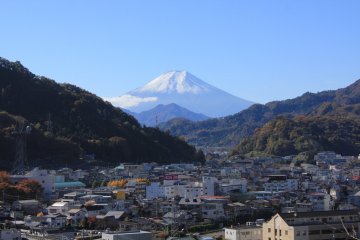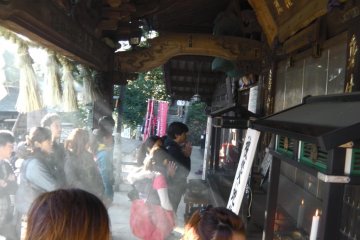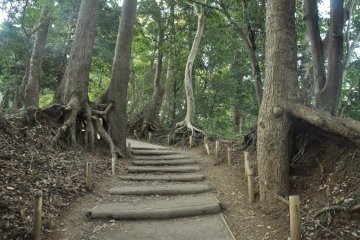Consisting of rural Tokyo, Kanagawa, and Yamanashi Prefectures, the area just west of the Tokyo Metropolis has long held many of Japan’s most visited tourist destinations. The area's appeal has much to do with its diverse scenery and rich cultural heritage, the latter encompassing everything from beautifully preserved historical estates and bridges to outdoor art galleries and cutting-edge museums.
For more ideas, be sure to check out our companion article covering the same region with more of a natural destination focus.
Share your own favorite destination just outside Tokyo below.
Saru Bridge (Saruhashi) – Otsuki, Yamanashi
An unusual bridge indeed … legend has it was inspired by monkeys.
Saru Bridge is one of Japan's top three strange and unusual bridges – yes there is a ranking for that! Local legend has it that the unique cantilevered bridge design was inspired when the architect saw monkeys holding hands to cross the river. Hence the bridge was named Saru (monkey) Bridge. The bridge was originally constructed 1300 years ago without using a bridge pike or traditional bridge building methods. Several support beams decorated with roof tiles create a beautiful structure though perhaps the most beautiful part is the views of the river gorge over 70 meters below. Many tourists visit the area in the fall via boat cruise where the autumnal leaves provide an even more magnificent view.
Travel time: ~75 minutes
Train - Shinjuku Station --> Saruhashi Station (Chuo Line) --> Walk --> Saruhashi Bridge
Kurochaya – Akiruno, Tokyo
A gastronomical journey … a perfect harmony of food and nature.
More than 250 years ago the village head of Akiruno built his home in a secluded location in the mountains. Surrounded by forests and mountains, there was no lack of local vegetables and ingredients. The river running through the grounds provided abundant fish and energy with through water mills. Today, Kurochaya remains a testament to the same concepts serving grilled mountain village cuisine in the scenic Akigawa Valley backdrop.
Arriving at Kurochaya, guests are greeted to a large water wheel and paths through pristine Japanese gardens leading back to multiple traditional Japanese structures built into the mountain. The scenery is simply unbelievable and upon entering you may never want to leave. Courses are set to match the season and include charcoal grilled seasonal ingredients and river fish served in wicker baskets and bamboo arrangements. Grill your fish and cook the nabe in front of you while taking in the views through large windows all around. Local sake from Akiruno complements the tastes perfectly.
Travel time: ~75 minutes
Train - Shinjuku Station --> Haijima Station (Chuo・Ōme Line) --> Musashi-Itsukaichi Station (Itsukaichi Line)
Bus - Masashiitsukaichieki Bus Stop --> Nishionakano Bus Stop
Walk - Nishionakano Bus Stop --> Kurojaya
Takao Yakuo-in Temple – Hachioji, Tokyo
Peace, nature and asceticism … discover the live of a mountain monk.
The Buddhist temple on Mount Takao was established in 744 as a base for Buddhism in Eastern Japan. The temple is filled with statues and images of the long-nosed beasts known as Tengu who are thought to inhabit Takao and fan away misfortune replacing with good.
Within the temple several mountain monk activities and rituals can be observed and experienced. The Goma fire ritual is performed daily to lead people to a higher spiritual realm by casting prayer requests into great flames as the devotees perform mantra chanting. Ascetic training activities are available on certain days and include fire-walking, waterfall training (stand beneath the waterfall while reciting mantra). Shojin-ryori is the Buddhists vegetarian cuisine mean to venerate life and bring forth the bounties of nature.
Travel time (to Mount Takao): ~60 minutes (30~60 minutes to summit by cable car and walk)
Train - Shinjuku Station --> Takaosanguchi Station (Keio Line)
Walk - Takaosanguchi Station --> Kiyotaki Station (cable car)
Yamanashi Maglev Exhibition Center – Tsuru, Yamanashi
Float on magnets at 500 km/h … the future in transportation.
The future of transportation in Japan is on full display at the Yamanashi Maglev Exhibition Center. Ultra-high-speed magnetic levitation is the future in public transportation for Japan with the first working models exceeding speeds of 500~600 km/h and the first major release connecting Tokyo to Nagoya planned to launch within the next ten years. In the museum learn the concepts behind Maglev technology (supercooled magnets floating 10 cm above rail) through demonstrations small and large. Float on air in the miniature maglev ride and head out to the observation deck to see the full-size maglev train race by in an instant. Well catered for families, there are gift shops, costume and photo areas, craft rooms and nursing rooms. The center uses a multilingual subtitle service that provides information in English Chinese and Korean.
Travel time: ~75 minutes
Train - Shinjuku Station --> Otsuki Station (Chuo Line)
Taxi - Otsuki Station --> Yamanashi Maglev Exhibition Center (~2,500 ~ 3,000 JPY)
JAXA Sagamihara Campus – Sagamihara, Kanagawa
Reaching to the skies … space exploration in Japan.
The Japanese Aerospace Exploration Agency, or JAXA, is the official space research agency in Japan. Similar to NASA, museums are constructed around Japan to display famous moments in Japan space history. The Sagamihara campus is primarily responsible for the launch of the Hayabusa craft, un unmanned spacecraft designed to visit asteroids, collect samples and return to Earth.
The campus houses a large exhibition area with tours taking you through the history of the Japan space program. View and touch actual spacecrafts and asteroid material that was collected by the program. Just outside full-size rocket replicas approximately 30 meters in length are a giant to behold. In the cafeteria and gift shops, there are a ton of space related goodies and interesting space foods to munch on.
Travel time: ~60 minutes
Train - Shinjuku Station --> Machida Station (Odakyu Line) --> Fuchinobe Station (Yokohama Line)
Walk - Fuchinobe Station --> JAXA Sagamihara Campus



















